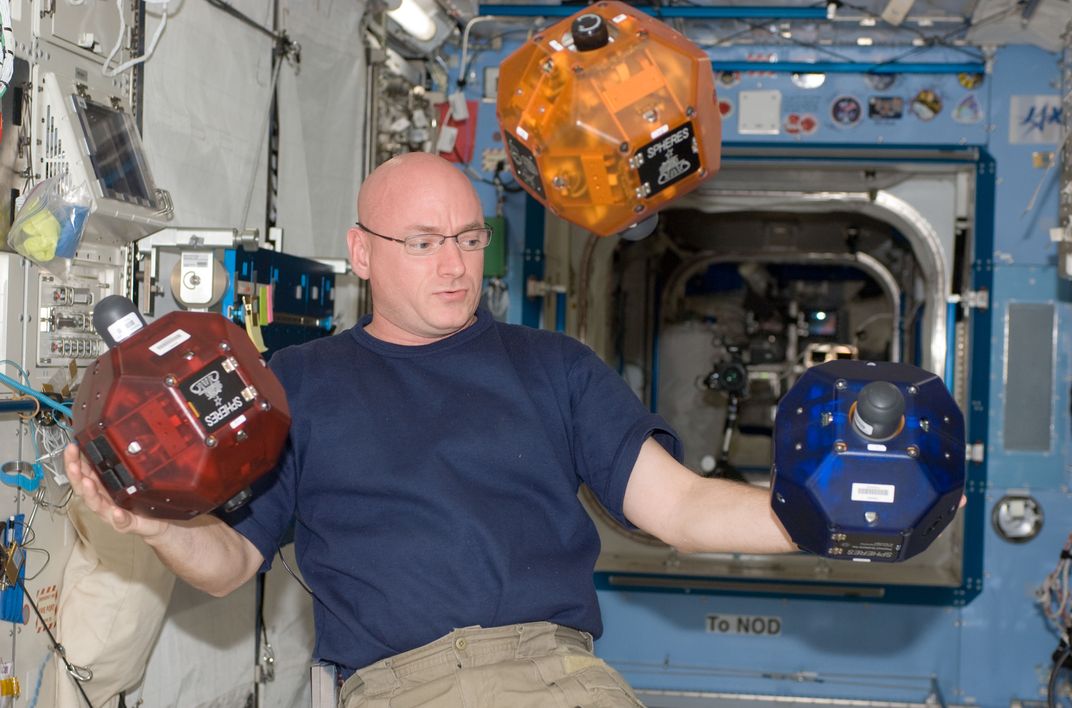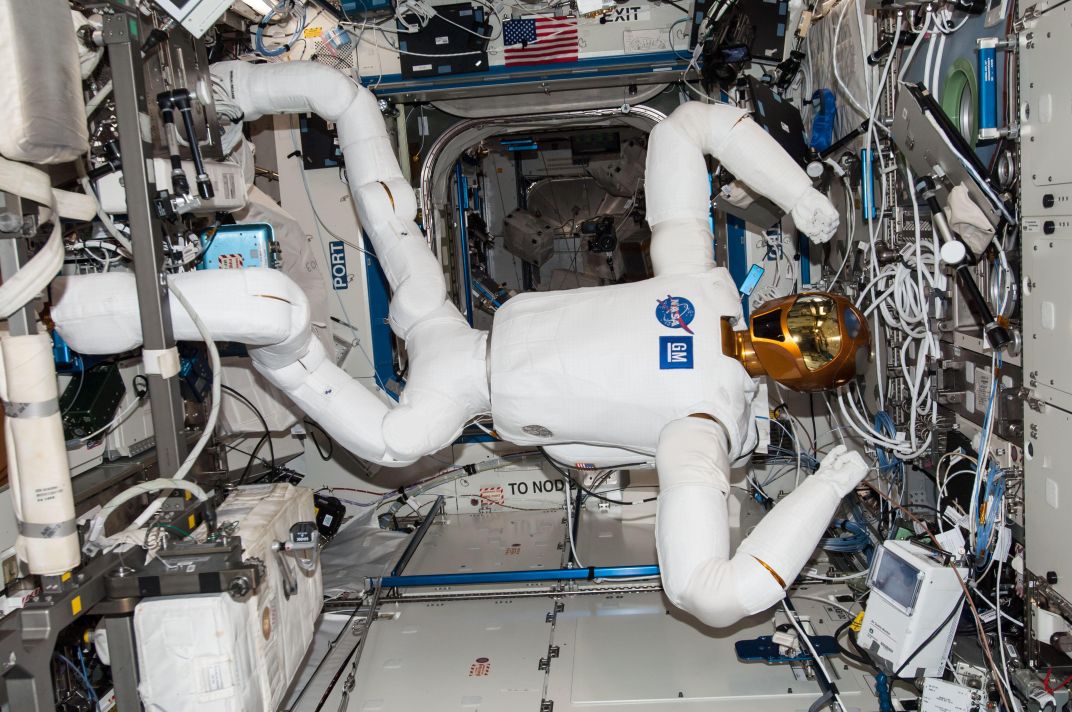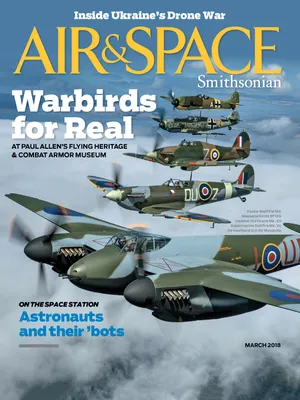Robot Helpers Are Coming to the Space Station
The astronauts are about to get some mechanical assistance.
/https://tf-cmsv2-smithsonianmag-media.s3.amazonaws.com/filer/e9/48/e9480635-1ad3-434c-9940-9fd1febeeae5/02f_fm2018_opener_live-wr.jpg)
Sometime in the late 1990s—Yuri Gawdiak can’t remember when exactly—he started hearing from NASA astronauts that they were chronically overscheduled in orbit.
There was never enough time for all the planned science experiments, let alone the mundane housekeeping tasks, from cleaning to taking inventory. And the situation was about to get worse: The International Space Station would soon open for business.
So Gawdiak came up with an idea. A free-floating robot, the size and shape of a volleyball, could work alongside the crew, lending a robotic hand, or eye, or brain, as needed. Here’s how Gawdiak and his colleagues at NASA’s Ames Research Center, where he was then a research engineer, imagined their Personal Satellite Assistant in 2001:
“A crewmember is awoken by a PSA at the requested time. The astronaut asks for a video briefing on the latest events, schedule changes and priorities while she washes and eats breakfast…. The PSA’s are not just passively waiting to be told what to do. They are actively looking for ways to be helpful to the humans….”
Back then, he says, “nobody had thought about operating a spacecraft within a spacecraft.” In hindsight, he admits the PSA concept was technologically ahead of its time, particularly in the software required for it to work and move independently around the spacecraft. Like many NASA advanced projects, it never made it to space.
Almost 20 years later, a squarish, free-flying gadget very much like the PSA, called Astrobee, will be sent to the space station on a Cygnus cargo mission scheduled to launch this spring. For now, Astrobee is classified as experimental, but its creators hope it eventually will see regular duty as a robotic sidekick for the astronaut crew: taking pictures, monitoring the cabin atmosphere, reading barcode-like radio-frequency identification (RFID) tags used to track food, spare parts, and other station supplies, and handling whatever other menial chores it can.
Astrobee owes less to Yuri Gawdiak than to an ongoing experiment called SPHERES, which ranks among the most versatile technologies ever flown on the station. Since they arrived on board in 2006, the three bowling-ball-size SPHERES have been used by dozens of researchers and students as a testbed for demonstrating free-flying robotics in space.

Astrobee improves on SPHERES in a number of key ways. To move itself around the cabin (at a safe top speed of a few inches per second), it will use ducted fans rather than carbon dioxide jet thrusters. “We hope to be quiet,” says Jonathan Barlow, the project’s test manager at Ames, in Mountain View, California. During its first few weeks, Astrobee will create its own internal map of the station, so as to be able to navigate autonomously, without having to rely on radio or wi-fi links to onboard systems. Unlike SPHERES, Astrobee will eventually have the run of the entire (non-Russian) side of the station. It has a robot arm for perching on handrails, and more arms could be added. When it’s not needed, it will remain docked to its charging port.
The closest thing astronauts have today to a mechanical sidekick is Robonaut, the golden-faced, dexterous humanoid launched to the station in 2011. But despite having passed all its benchmark tests—demonstrating, for example, that it can flip a switch, or respond to commands from the ground—Robonaut’s career hasn’t progressed the way its creators had hoped. Currently it’s sidelined by a fault in its power supply, and the robot hasn’t been in full working order since its legs arrived (separately from the torso and head) in 2014. Robonaut is great for publicity photos—the fists-raised boxing pose is a favorite—and it graces the cover of many a NASA publication about future technology. But it’s always been treated as an experiment, and is unlikely ever to be given a real job on the station.
“It’s too big to do anything useful inside. I mean, it takes up the entire hallway,” says Terry Virts, a former astronaut who served as the station’s commander in 2015. At one time Virts headed the astronaut office’s robotics branch, and when Robonaut’s legs arrived on the station, it was Virts who tried to power them up. He and others had hoped the humanoid robot would find its niche working outside the station, helping astronauts set up their tools and worksite before spacewalks. “That would save hours of time every year,” he says. But funds to develop that capability never came through.
Even its inventors admit that Robonaut, with its sophisticated dexterous hands, may be overkill for the kinds of tasks astronauts need help with most.

An experiment called MANTIS (Modular Advanced Networked Telerobotic Interface System), developed by Seattle-based Tethers Unlimited under one of NASA’s small business research grants, would help unburden the crew, says principal investigator Blaine Levedahl, by taking on some of the simple, routine jobs that busy station astronauts seem to have trouble getting around to. (“There have been parts that have sat on the 3D printer for six weeks just waiting for an astronaut to remove it,” Levedahl says.)
The first task MANTIS’s developers plan to demonstrate is using the device’s three-foot robot arm, commanded from the ground, to transfer sample plates used in microgravity life science experiments from one equipment locker to another. But Levedahl says if MANTIS makes it to space in 2019, as he hopes, the telerobot will be made available to other researchers, who are sure to find other applications. MANTIS, like Astrobee, would start small, prove its value, and eventually become part of the team.
Currently, NASA plans for a Deep Space Gateway spacecraft to be positioned in Earth-moon orbit, starting in the mid-2020s. The vehicle would be occupied only intermittently by astronauts, so there will be times when no humans are on board to maintain critical systems. Roboticists say this is the perfect time to push for automation.
First, though, NASA will have to modify its conservative culture. Getting any new, untested technology into orbit, even as an experiment, takes perseverance. Says Virts, “Silicon Valley’s reality is often several steps ahead of NASA’s. You know the joke: NASA puts the ‘no’ in innovation.” But that’s understandable, he says, given the need for safety. So, as things stand, “robots have promise, but we aren’t there yet.” Experiments like Astrobee and MANTIS are meant to blaze the trail. And they have the advantage of coming at a time when robot capabilities are advancing rapidly in other fields. “It’s very hard to beat something that can operate 24/7, and doesn’t need any kind of social or emotional overhead,” says Yuri Gawdiak, who dreamed of the mechanical astronaut helper 20 years ago. Not to mention, he adds, “you can sacrifice it without any issues of conscience.”
